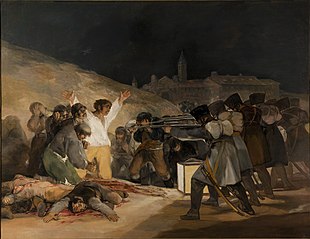Peninsular War
![]()
This article or subsequent section is not sufficiently supported by evidence (e.g., anecdotal evidence). Information without sufficient evidence may be removed in the near future. Please help Wikipedia by researching the information and adding good supporting evidence.
Battles of the Napoleonic Wars on the Iberian Peninsula 1808-1813
Bailén - Roliça -Vimeiro - Saragossa (1808) - Burgos (Gamonal) - Medina de Rioseco - Espinosa - Tudela - Somosierra - Saragossa (1809) - La Coruña - Torres Vedras - Valls - Braga - Oporto - Talavera - Ocaña - Gerona - Ciudad Rodrigo (1810) - Buçaco - Gévora - Barrosa - Badajoz (1811) - Fuentes de Oñoro - La Albuera - Tarragona (1811) - Sagunt (Murviedro) - Ciudad Rodrigo (1812) - Badajoz (1812) - Majadahonda - Salamanca - García Hernández - Venta del Pozo - Vitoria - Sorauren - San Sebastián - Bidassoa
Napoleon Bonaparte's campaign on the Iberian Peninsula lasted from 1807 to 1814. On the Spanish side it is called the Spanish War of Independence (Guerra de la Independencia Española), on the British side the Peninsular War. The Peninsular War is a part of the Napoleonic Wars, in which mainly Spain, Portugal and Great Britain fought against French domination. It began as an attempt by France to involve Portugal in the trade blockade against Great Britain.

Francisco de Goya - The shooting of the insurgents on 3 May 1808
Previous story
The First Consul of France Napoleon Bonaparte forced the Treaty of San Ildefonso on Spain in October 1800. This Franco-Spanish alliance led to a resurgence of conflict with the United Kingdom of Great Britain and Ireland. Manuel de Godoy became the "strong man" of Spain, while formally Pedro Ceballos Guerra served as prime minister. In early 1801, Godoy was appointed Generalissimo and Admiral of Spain and "India" (the term for Spanish America). The Peace of Amiens (March 1802) between Britain and France provided Spain with a brief but much-needed respite. In December 1804, Godoy declared war on the United Kingdom. The Franco-Spanish fleet suffered a crushing defeat at the Battle of Trafalgar on 21 October 1805. Godoy's opponents personally blamed him for the high losses in men and material and demanded the termination of the alliance with France. Therefore Godoy called for war against France in October 1806. But already at the beginning of 1807 he had to end his anti-French policy. Napoleon I. demanded the provision of 15.000 Spanish soldiers. These soldiers fought in the Napoleonic army in Northern Germany and East Prussia against Prussia and Russia (Fourth Coalition War).
On November 21, 1806, Napoleon decreed the Continental Blockade, an economic blockade, over the British Isles. It was intended to bring Great Britain to its knees by means of economic warfare. In addition, the Continental Blockade was intended to protect the French economy against any European and transatlantic competition. Since it was not possible to reach a treaty agreement with Portugal to comply with the blockade, Napoleon intended to invade Portugal.
On 27 October 1807, France and Spain concluded the secret Treaty of Fontainebleau. In this treaty they agreed on the conquest and partition of Portugal. In order for the French troops to reach Portugal by land, Spain granted the French passage through its territory. At the end of 1807, General Jean Andoche Junot received from Napoleon the command of the troops assembled at Salamanca to occupy Portugal. As early as October 17, 1807, Napoleon wrote Junot an order that he must be in Lisbon by December 1, as friend or foe. Junot complied, within 11 days the French marched in forced marches from Salamanca to Abrantes, close to Lisbon. On November 30, Junot and 1500 soldiers entered the city without a fight. The day before, King João VI and his court, accompanied by the government and important nobles, had left for Brazil by sea.
.jpg)
Manuel de Godoy
French invasion
At the beginning of 1808, French troops began to occupy strategically important places in Spain. This development prompted the Spanish King Charles IV to plan the transfer of his throne to a safer country, such as Mexico. When the plans became known among the population, it led to an uprising, which was primarily directed against the government and person of Godoy. When Charles learned that his son Ferdinand had asked Napoleon for help against Godoy and French troops were invading Spain, the royal family fled to Aranjuez. On March 17, 1808, the Mutiny of Aranjuez broke out; the king was arrested and forced to have Godoy arrested. His son was hailed by the people as King Ferdinand VII the following day, but was forced to relinquish the crown on May 6 under pressure from the French. Charles, his wife and Godoy fled to France, where Charles was forced to abdicate the Spanish throne in favour of Napoleon's brother Joseph Bonaparte.
On 10 April 1808, Ferdinand left for Bayonne to negotiate with Napoleon, leaving the government in his absence to a council of regency chaired by his uncle Antonio Pascual de Borbón. On 20 April 1808, Ferdinand and, at the end of April 1808, Charles IV arrived in Bayonne from Aranjuez. There, after prolonged balking, Ferdinand returned the crown to his father on 6 May 1808 and placed himself under the protection of Napoleon, who ordered him to stay at Valençay Castle with an annual pension of one million francs. Charles had already previously agreed to his resignation in favour of Joseph Bonaparte. De facto, this operation was a capture of the royal family by Napoleon.
.jpg)
Charles IV and his wife Queen Maria Louisa, detail from The Family of Charles IV by Goya.
Search within the encyclopedia